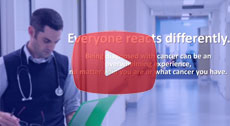Liver cancer
Liver cancer can be divided into two categories:
- Primary liver cancer
- Secondary liver cancer
Primary liver cancer is a rare type of tumour that begins in the liver. It is much more common in men than in women and is more likely to affect people as they get older. There are different types of primary liver cancer:
- hepatocellular carcinoma (HCC) or hepatoma, (the most common) starts in the main cell type in the liver, the hepatocytes
- cholangiocarcinoma, or bile duct cancer, starts in the cells lining the bile ducts (which connect the liver to the bowel and gall bladder)
- angiosarcoma starts in the blood vessels. This is a rare type of liver cancer that is more likely to occur in people over 70.
Secondary cancer in the liver is more common than primary liver cancer. Secondary cancer happens when cancer cells spread to the liver from a primary cancer somewhere else in the body.
If you have secondary liver cancer, you may find it helpful to read information about your primary cancer as well. Any type of cancer can spread to the liver. Common types that do include:
View Cancer Council Australia information on liver cancer and optimal care pathways for liver cancer – what to expect.
Patient stories
(Disclaimer: All patient stories are based on real life experiences as told to us. The stories are portrayed by actors to protect privacy and confidentiality.)
Treatments
Radiation therapy
What is radiation therapy?
- Radiation therapy is the use of high energy x-rays (called ionising radiation) to treat cancer.
Managing side effects
We’ve created some short videos to help you understand the radiation therapy process. Be sure to ask you treatment team for more information if you have any questions or concerns.
Chemotherapy
What is chemotherapy?
- Chemotherapy is a term for a large number of drugs with different methods of working and different side effects. It is used to improve the chance of cure or to control the growth of cancer cells.
Managing side effects
- Advice on managing potential side effects of chemotherapy treatment.
We’ve created some short videos to help you understand the chemotherapy process. Although these have been filmed at the Royal Brisbane and Women’s Hospital you will go through a similar process at other facilities.
Coming for your chemotherapy
There are a number of things you’ll need to know for you first visit for chemotherapy. Your doctor will review any tests and scans and discuss your diagnosis and treatment options with you. Don’t forget to bring your scans and test results. You’ll also need a blood test before each visit. This video shows a typical session at the Royal Brisbane and Women’s Hospital, but you will go through a similar process at other facilities.
Your chemotherapy treatment
This video shows a typical chemotherapy treatment session at the Royal Brisbane and Women’s Hospital, but you will go through a similar process at other facilities. You will learn about the process and the safety procedures we use to make sure your treatment is as effective and safe as possible.
Resources
Waste products at home
CADD Pumps
If you have a Central Venous Access Device
Surgery
Sometimes surgery is the most effective approach for a particular type of cancer. Your doctor will discuss this with you as part of your treatment.
Other treatments, such as chemotherapy or radiation therapy, can be given before, during or after surgery.
Surgery is a medical treatment performed by a surgeon or a surgical oncologist to remove cancer from the body or repair a part of the body affected by cancer. It’s sometimes called an operation.
Cancer Council Australia resources
Targeted therapies
Targeted therapy uses drugs to kill or slow the growth of cancer cells. The treatment works by selectively targeting particular types of cancer cells while minimising harm to normal, healthy cells.
Targeted therapies can be used for different reasons and may be used instead of, or in combination with chemotherapy. Not all cancers respond to targeted therapies, and some of these therapies are only available in clinical trials.
Cancer Council Queensland resources
Supporting your treatment
As part of your cancer journey you may see one or more of our Allied Health professionals.
Cancer research
Cancer care Services has an active research program through our collaboration with a range of world-class research organisations.
QIMR Berghofer
QIMR Berghofer is one of Australia’s most successful medical research institutes and conducts extensive research on different cancer types. Metro North HHS and QIMR Berghofer partner on a range of cancer studies through our hospitals and our membership of Brisbane Diamantina Health Partners.
Brisbane Diamantina Health Partners
Brisbane Diamantina Health Partners is an academic health science network. Its members include hospital and health services, primary care, universities and medical research institutes who collectively take local and international research and accelerate its application to new treatments across the spectrum of health care.
Herston Imaging Research Facility (HIRF)
Located at the Royal Brisbane and Women’s Hospital, HIRF has been purpose-built to facilitate imaging research and clinical trials. Its state of the art clinical scanners and prime location within Australia’s largest hospital precinct position it as a leading global force in clinical imaging research.
Australian Cancer Research Foundation
The Australian Cancer Research Foundation provides news, information and leading opinions on treatment, prevention, diagnosis and cure.
Clinical trials
Clinical trials test new treatments to find better ways to prevent, detect or treat disease. Both healthy people and people with a disease or condition can volunteer to be part of a trial.
Cancer Care Services participate in a range of clinical trials at our hospitals. For information about any of the trials below, ask your doctor or nurse.
For information about clinical trials in general visit the Australian Clinical Trials website or search the Australia and New Zealand Clinical Trials Registry.
Support groups and resources
Liver cancer specific
Support for carers
Aboriginal and Torres Strait Islander people
General support groups
- Cancer Connections
- CanSpeak Qld
- Canteen
- Headspace – wellbeing for 12-25 year olds
- Leukaemia Foundation
- Look Good Feel Better
- Mummy’s Wish
- PalAssist (Palliative Care Assistance)
- Palliative Care Australia
- Rare Cancers Australia
- Redkite
Information and advice
- Cancer Care Services Resources page
- Advance Care Planning Australia
- Cancer Australia
- Cancer Council
- Macmillan Cancer Support (UK site)
- Cancer.Net (US site)
- eviQ Cancer Treatment Protocols Online (including drug protocols and other resources)
Member access
Username: MNCCS
Password: patient




